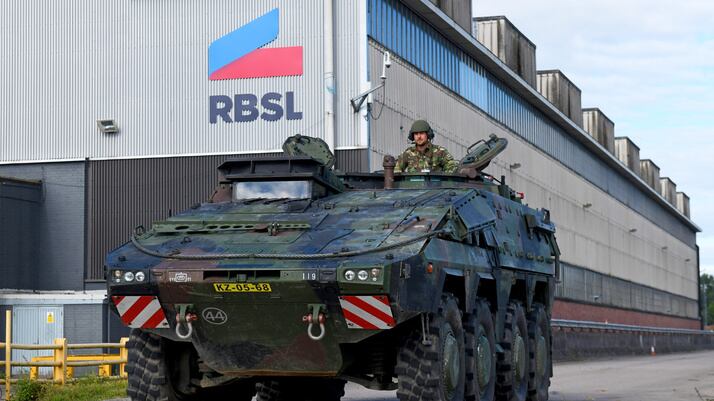LONDON — Britain’s newly declared focus on combating hybrid threats will have no bearing on the Army’s priority to invest in armored vehicle programs, according to officials.
The creation of a new formation, known as the 6th Division, to counter Russia, among others, in cyberspace, information operations and other non-kinetic tactics is a sign of the changing nature of warfare.
“The priorities at the moment are absolutely about delivering the modernization of our armored fighting vehicle fleet: Warrior, Challenger 2 and Mechanised Infantry Vehicle,” according to a senior service official, who spoke on condition of anonymity. “These remain our priorities for the foreseeable future until those vehicles are delivered.”
Rebalancing the Army to combat hybrid warfare will not be at the expense of capabilities needed on conventional battlefields, said the official. Put another way: The utility of the tank and other armored fighting vehicles remains uncontested for now.
As one Australian general at a recent land warfare conference in London noted: “You can cyber all you like, but there comes a time when only a tank will do.”
The problem for the British forces, however, is that much of their armored fighting vehicle capability is found wanting, which is partly why modernization remains a priority.
The land forces have a quality deficit that is only now being fixed after years of development delays in the Warrior program, budget issues and requirement uncertainty that stalled the Challenger 2 update and new requirements for the eight-wheel drive Mechanised Infantry Vehicle, or MIV.
RELATED

Penny Mordaunt, the then-defense secretary, highlighted the problem in a June 4 speech at a conference, warning Britain had fallen behind its allies and potential adversaries in key armored combat vehicle capabilities.
Labeling Challenger 2 and Warrior as “obsolete,” she said that while the battlefield may look very different in the future, armored vehicles “must be capable, and we must be competitive. We have not been.”
It now looks as though some of the issues that have dogged armored fighting vehicle procurement in Britain for more than a decade will be resolved.
Questions remain around actual numbers, timing and capabilities of vehicles to be purchased or updated by a perennially cash-strapped Defence Ministry, but the three key programs appear to be moving in the right direction, albeit not as quickly as some would hope.
For example, General Dynamics UK is delivering variants of the Ajax tracked scout vehicle family to the Army under a $4.3 billion production order for 589 machines. The Ajax, along with the MIVs, are the key components of the two new strike brigades with the British Army.
Britain selected, without competition, the Boxer wheeled personnel carrier by Rheinmetall and Krauss-Maffei Wegmann to meet a requirement of some 500 vehicles. The recently formed joint venture, known as Rheinmetall BAE Systems Land, will be the key player in the program, with the vehicles built at what was previously BAE Systems’ Telford facility.
“The assessment phase [on MIV], concluding later this year, will consider the benefits of manufacturing locations and different supply chains for Boxer, as well as value for money,” the Ministry of Defence said in a statement. “The aim is to have the first vehicles in service in 2023.”
The MoD declined to discuss the Challenger 2 life-extension program beyond saying: “Approval has been given for the Challenger 2 LEP to undertake additional assessment phase work.”
Previously, BAE Systems and Rheinmetall conducted rival assessment phase studies on Challenger 2. That was brought to a halt July 1 when the two companies announced their German majority-owned partnership.
Meanwhile, Lockheed Martin UK has struggled to complete development of a substantially updated Warrior since receiving a contract in 2011. The program has been dogged by delay and overspending; for the moment it remains in the development phase. But the MoD said in a program assessment this year there was “evidence the issues were beginning to be overcome.”
“Two significant milestones have recently been achieved on time: live crew clearance, which allows MoD turret crews to conduct live firing [of the CTAI 40mm cannon], and the successful completion of the first 20 battlefield missions,” the ministry told Defense News on July 19.
Testing will continue into 2020. The MoD assessment said it expects to commit to a manufacturing contract during that year.
Armored fighting vehicles may be the top priority, but they are far from the only weapons on Britain’s shopping list. Among the other programs is a multirole protected logistics vehicle, with part of the requirement expected to be filled by the U.S. Joint Light Tactical Vehicle in a much-delayed Foreign Military Sale deal now likely next year.
New GPS-guided rocket systems, land precision strike missiles and 155mm mobile fires platforms are also among weapons on the British Army’s wish list.
Andrew Chuter is the United Kingdom correspondent for Defense News.








